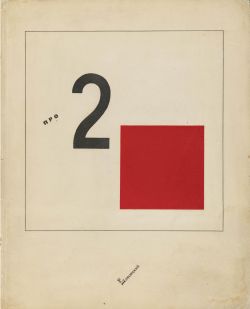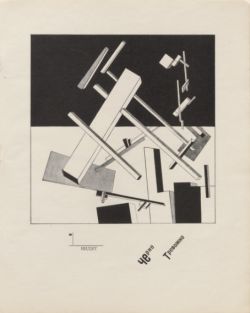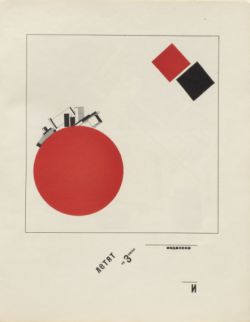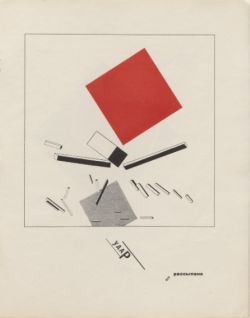Many Russian artists supported the Revolution of 1917, which was led by Vladimir Lenin against the old Tzarist regime, and established the first communist government. They turned their talents to promoting the social justice they believed it would bring, through Suprematism, a new abstract style in Russian art, with roots in cubist and futurist systems of painting. The creator, Kazimir Malevich, was head of the UNOVIS (Utverditeli Novovo Iskusstva or The Champions of the New Art). The role of UNOVIS was to teach the suprematist system and apply its principles to construction, architecture, theatre, book design, and graphic arts in general. Among the key faculty was Lazar (“El”) Lissitzky, who drew propaganda posters for the Communist Party and designed their first flag. He was a leading proponent of the Suprematist movement and began a series of projects called PROUNS1, with which he hoped to move Suprematism from a two dimensional platform to a three-dimensional one through his architectural expertise.
A graphic typography book, created during 1920, and published in its final form in Berlin in the spring of 1922, demonstrated how the combination of the graphic word and letter can visually complement each other to create a pictorial image in a higher dimension. The book was titled Pro Dva Kvadrata (About Two Squares), and is considered today, to be Lissitzky’s masterpiece of Suprematist book illustration. The book is portrayed as a children’s tale, depicting the adventures of the red square (communist ideals), as it overcomes the black square (convention), that fly to earth from afar to create a better world. With six main plates which encapsulate a breakthrough in typographic art with cryptic social political messages, the book is simplified to appeal to children in the form of a fable. It is based upon “the supremacy of pure artistic feeling” rather than on a visual depiction of objects.
Chaos is depicted using words “black” and “alarming”, with a disorganized mix of slanting blocks and angular objects which float disturbingly in midair without any sense of perspective or logic.
With this abstract and artistic image, the political message is quite clear: On course to attend the chaos on planet earth, the Soviet red square is ahead of the old order black square.
Finally order is on the way. Even though a corner of the red square crashed down on the chaotic objects below, scattering them, a sense of order seems to have been achieved with the items being re-arranged by shape and size, with the words “crash” and “scattered” printed.
About Two Squares depicts the victory of the new over the old, and a higher consciousness of reality over three-dimensional consciousness. It transmits a reality beyond that of earthly three-dimensional determinism and limitation by which man’s perception of art had been associated with. Lissitzky, using non-Euclidean geometry of point, line and plane, coupled with his architectural projective methods, was able to create suprematist forms in cosmic space. Out of these notions, access to the realm of the fourth dimension becomes possible by releasing the imagination to embrace those higher dimensions of space and time. It is through the tale’s analogy that the reader can postulate the world of three dimensional beings, to the world of the fourth dimension.2
Suprematism remained mostly a Russia-based art movement. Although heavily criticized, it gained some popularity in the West as well. Lissitzky, in particular, was the one who made the movement popular in Western Europe with collaborations from representatives of similar movements, such as De Stijl and the Bauhaus.
While Suprematist artworks are very popular among collectors at auctions, our Rare Book Sales Monitor failed to record any significant price increase during recent years. The few surviving copies of the original Pro Dva Kvadrata, are very rarely up for sale. The most noticeable sale took place during a Sotheby’s auction in London, in 2006 for £19, 200; more than 3 times the high end of the estimate. Another copy offered in 2012, sold at a Christie’s London for £15,000; 25% above the high estimate. Three years later a similar copy sold for £18,750; close to the high end of the estimate. At the high art market, Malevich’s painting Suprematist Composition (1916) broke a few records, first during the recession in 2008 where the abstract painting was the star of the day setting the world record for Russian art at $60 million. The same work more recently, in 2018, sold for $85.8 million at Christie’s, breaking the record for a work of Russian art once again.
1 In 1920 Lissitzky coined the term “Proun”—an acronym for the Russian words meaning “project for the affirmation of the new”—to refer to a series of abstract works that combined the Suprematist lexicon of geometric, monochromatic forms with tools of architectural rendering.
2 Railing, Patricia. More About Two Squares. Artists Bookworks, 1990. Patricia Railing is an art historian specialising in the Russian Avant-Garde. She has published widely on Cubism and Suprematism in both books and articles.





{ 0 comments… add one now }